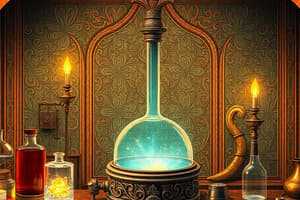Podcast
Questions and Answers
What is the identity of a gas that weighs 0.512 g, occupies a volume of 0.777 L at 1.00 atm and 373 K?
What is the identity of a gas that weighs 0.512 g, occupies a volume of 0.777 L at 1.00 atm and 373 K?
- Helium
- Xenon
- Krypton
- Neon (correct)
What temperature must be achieved to expand a balloon from 4.00 L to 6.00 L if it starts at 282 K?
What temperature must be achieved to expand a balloon from 4.00 L to 6.00 L if it starts at 282 K?
- 578 K
- 423 K
- 629 K (correct)
- 366 K
What will the volume of nitrogen gas be if it is at 1.35 atm and 253 K, originating from 25.0 L at 3.39 atm and 353 K?
What will the volume of nitrogen gas be if it is at 1.35 atm and 253 K, originating from 25.0 L at 3.39 atm and 353 K?
- 45.0 L (correct)
- 58.6 L
- 22.2 L
- 11.4 L
How many milliliters of a 9.0 M solution of H2SO4 are needed to create 0.25 L of a 3.5 M solution?
How many milliliters of a 9.0 M solution of H2SO4 are needed to create 0.25 L of a 3.5 M solution?
What is the total vapor pressure over a solution of hexane and toluene if the mole fraction of hexane is 0.580 and their individual vapor pressures are known?
What is the total vapor pressure over a solution of hexane and toluene if the mole fraction of hexane is 0.580 and their individual vapor pressures are known?
What will be the freezing point of a solution made with 50 grams of KCl in 5500 grams of water?
What will be the freezing point of a solution made with 50 grams of KCl in 5500 grams of water?
For what conditions would a 0.25 L volume of argon, initially at 282 K, reach a pressure of 2.00 atm?
For what conditions would a 0.25 L volume of argon, initially at 282 K, reach a pressure of 2.00 atm?
How many grams of H2SO4 would be needed to prepare 160 mL of a 3.5 M solution?
How many grams of H2SO4 would be needed to prepare 160 mL of a 3.5 M solution?
What is the molality of KCl in the solution prepared with 35.0 g of KCl in 225 g of water?
What is the molality of KCl in the solution prepared with 35.0 g of KCl in 225 g of water?
Given a vapor pressure of 75 torr for a mixture of A and B, what can be inferred about their intermolecular forces?
Given a vapor pressure of 75 torr for a mixture of A and B, what can be inferred about their intermolecular forces?
What is the fate of the vapor pressure of pure water when a nonvolatile solute like C2H6O2 is added?
What is the fate of the vapor pressure of pure water when a nonvolatile solute like C2H6O2 is added?
Calculate the vapor pressure of a solution with a mole fraction of C2H6O2 equal to 0.0504, knowing the vapor pressure of pure water is 23.8 torr.
Calculate the vapor pressure of a solution with a mole fraction of C2H6O2 equal to 0.0504, knowing the vapor pressure of pure water is 23.8 torr.
What is the molecular weight of the nonvolatile solute C2H6O2?
What is the molecular weight of the nonvolatile solute C2H6O2?
Which statement about the kinetic energy of gas molecules is correct?
Which statement about the kinetic energy of gas molecules is correct?
What is the molar mass of the unknown gas if nitrogen gas takes 10.00 s to effuse and the unknown gas takes 18.12 s?
What is the molar mass of the unknown gas if nitrogen gas takes 10.00 s to effuse and the unknown gas takes 18.12 s?
Which gas is expected to behave the most ideally under extreme conditions?
Which gas is expected to behave the most ideally under extreme conditions?
Under which conditions are gases most likely to behave ideally?
Under which conditions are gases most likely to behave ideally?
What is the molarity of Br− in a 0.110 M CaBr2 solution?
What is the molarity of Br− in a 0.110 M CaBr2 solution?
Calculate the mass percent of KCl in a solution made by dissolving 35.0 g of KCl in 225 g of water.
Calculate the mass percent of KCl in a solution made by dissolving 35.0 g of KCl in 225 g of water.
What is the mole fraction of KCl in a solution containing 35.0 g of KCl and 225 g of water?
What is the mole fraction of KCl in a solution containing 35.0 g of KCl and 225 g of water?
What is the molarity of KCl in a solution if 35.0 g of KCl is dissolved in 239 mL of total solution?
What is the molarity of KCl in a solution if 35.0 g of KCl is dissolved in 239 mL of total solution?
What is the equation for kinetic energy of light given in the content?
What is the equation for kinetic energy of light given in the content?
Which of the following constants represents Avogadro's number?
Which of the following constants represents Avogadro's number?
Which formula calculates the root mean square speed of gas molecules?
Which formula calculates the root mean square speed of gas molecules?
What is the relationship between pressure, total pressure, and mole fractions represented by the formula?
What is the relationship between pressure, total pressure, and mole fractions represented by the formula?
Which equation is used to relate the internal energy change to heat and work?
Which equation is used to relate the internal energy change to heat and work?
What is the value of the van't Hoff factor for a 1.83 m (NH4)2SO4 solution if the boiling point is 102.5 °C and Kb for water is 0.512 °C/m?
What is the value of the van't Hoff factor for a 1.83 m (NH4)2SO4 solution if the boiling point is 102.5 °C and Kb for water is 0.512 °C/m?
Which of the following statements correctly ranks the solutions by increasing osmotic pressure?
Which of the following statements correctly ranks the solutions by increasing osmotic pressure?
Which compound is expected to act as a weak electrolyte?
Which compound is expected to act as a weak electrolyte?
Which of the following compounds is most soluble in octane?
Which of the following compounds is most soluble in octane?
How many moles of CO2 are released when raising the temperature of 1 liter of water from 20 °C to 25 °C at 1 atm?
How many moles of CO2 are released when raising the temperature of 1 liter of water from 20 °C to 25 °C at 1 atm?
What is the most likely outcome when a solution saturated with oxygen gas and potassium chlorate at 348 K is heated to 388 K?
What is the most likely outcome when a solution saturated with oxygen gas and potassium chlorate at 348 K is heated to 388 K?
What is the calculated density of xenon gas at a pressure of 0.976 atm and a temperature of 318 K?
What is the calculated density of xenon gas at a pressure of 0.976 atm and a temperature of 318 K?
Calculate the partial pressure of Ne in a gas mixture at 305 K and 2.00 atm with 1.56 mol of Ne and 2.22 mol of Ar.
Calculate the partial pressure of Ne in a gas mixture at 305 K and 2.00 atm with 1.56 mol of Ne and 2.22 mol of Ar.
Flashcards are hidden until you start studying
Study Notes
Gas Laws and Their Applications
- A 0.512-g sample of an unknown pure gas occupies a volume of 0.777 L at a pressure of 1.00 atm and a temperature of 373 K. The unknown gas is argon.
- A balloon filled with argon, initially at 282 K and 4.00 L, must be heated to 691 K to have a volume of 6.00 L.
- A large balloon initially filled to a volume of 25.0 L at 353 K and a pressure of 3.39 atm with nitrogen gas will contain 87.5 L of N2 at 1.35 atm and 253 K.
- The density of xenon gas at a pressure of 0.976 atm and a temperature of 318 K is 3.81 g/mL.
- In an effusion experiment, nitrogen gas effused from a container in 10.00 s, while an unknown gas took 18.12 s to effuse from the same container. The molar mass of the unknown gas is 70.90 g/mol.
Solutions and Their Properties
- The molarity of Br− in 0.110 M CaBr2 is 0.220 M.
- A solution containing 50 grams of KCl and 5500.0 grams of water has a freezing point of -1.23 C.
- The boiling point of an aqueous 1.83 m (NH4)2SO4 solution is 102.5 C. The van't Hoff factor for this solute is 2.7.
- The vapor pressure of an aqueous solution of C2H6O2 with a mole fraction of 0.0504 is 22.6 torr.
- Solutions can be classified as weak electrolytes, strong electrolytes, or non-electrolytes based on their ability to conduct electricity.
- Solubility is the maximum amount of solute that can dissolve in a given amount of solvent at a specific temperature.
- The solubility of a solid in a liquid usually increases with increasing temperature.
- The solubility of a gas in a liquid usually decreases with increasing temperature.
- The solubility of a gas in a liquid usually increases with increasing pressure.
Kinetic Molecular Theory and Ideal Gas Behavior
- The root mean square velocity of chlorine gas at 310 K is 470 m/s.
- Under conditions of low temperature and low pressure, gases are most likely to behave ideally.
- The average kinetic energy of gas molecules is proportional to the absolute temperature.
- Gases that are most ideal under extreme conditions include hydrogen (H2).
Colligative Properties
- Colligative properties are properties of solutions that depend only on the concentration of solute particles and not on the identity of the solute.
- Colligative properties include vapor pressure lowering, boiling point elevation, freezing point depression, and osmotic pressure.
- The vapor pressure of a solution is lower than the vapor pressure of the pure solvent.
- The boiling point of a solution is higher than the boiling point of the pure solvent.
- The freezing point of a solution is lower than the freezing point of the pure solvent.
- Osmotic pressure is the pressure that must be applied to a solution to prevent the inward flow of solvent across a semipermeable membrane.
Intermolecular Forces and Their Impact on Properties
- Intermolecular forces are attractive forces that exist between molecules.
- The strength of intermolecular forces affects a substance's physical properties such as boiling point, melting point, and viscosity.
- Stronger intermolecular forces lead to higher boiling points, melting points, and viscosities.
- The relative strengths of intermolecular forces between particles of A and B can be understood from the vapor pressure of the mixture.
Important Equations and Relationships
- P = 𝜒a Ptotal (where P is the partial pressure of a gas, 𝜒a is the mole fraction of the gas, and Ptotal is the total pressure)
- 𝑢𝑟𝑚𝑠 = √3𝑅𝑇/𝑀 (where 𝑢𝑟𝑚𝑠 is the root mean square velocity, R is the ideal gas constant, T is the temperature, and M is the molar mass)
- 𝑃𝑠𝑜𝑙𝑢𝑡𝑖𝑜𝑛 = 𝑛𝑠𝑜𝑙𝑣𝑒𝑛𝑡 𝑃°/ 𝑛𝑠𝑜𝑙𝑣𝑒𝑛𝑡 + 𝑖 ∙ 𝑛𝑠𝑜𝑙𝑢𝑡𝑒 (where Psolution is the vapor pressure of the solution, P° is the vapor pressure of the pure solvent, n is the number of moles, and i is the van't Hoff factor)
- 𝛱 = 𝑖 ∙ 𝑀𝑜𝑙𝑎𝑟𝑖𝑡𝑦 × 𝑅𝑇 (where 𝛱 is the osmotic pressure, i is the van't Hoff factor, Molarity is the molar concentration, R is the ideal gas constant, and T is the temperature)
- ∆𝑇 = 𝑖 ∙ 𝑚𝑜𝑙𝑎𝑙𝑖𝑡𝑦 ∙ 𝐾 (where ∆𝑇 is the change in temperature, i is the van't Hoff factor, molality is the molal concentration, and K is the molal freezing-point-depression constant or the molal boiling-point-elevation constant)
Studying That Suits You
Use AI to generate personalized quizzes and flashcards to suit your learning preferences.




